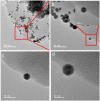Surface Interactions between Gold Nanoparticles and Biochar
- PMID: 28694426
- PMCID: PMC5503990
- DOI: 10.1038/s41598-017-03916-1
Surface Interactions between Gold Nanoparticles and Biochar
Abstract
Engineered nanomaterials are directly applied to the agricultural soils as a part of pesticide/fertilize formulations or sludge/manure amendments. No prior reports are available to understand the surface interactions between gold nanoparticles (nAu) and soil components, including the charcoal black carbon (biochar). Retention of citrate-capped nAu on 300-700 °C pecan shell biochars occurred rapidly and irreversibly even at neutral pH where retention was less favorable. Uniform organic (primarily citrate ligands) layer on nAu was observable by TEM, and was preserved after the retention by biochar, which resulted in the aggregation or alignment along the edges of multisheets composing biochar. Retention of nAu was (i) greater on biochars than a sandy loam soil, (ii) greater at higher ionic strength and lower pH, and (iii) pyrolysis temperature-dependent: 500 < 700 ≪ 300 °C at pH 3. Collectively, carboxyl-enriched 300 °C biochar likely formed strong hydrogen bonds with the citrate layer of nAu. The charge transfer between the conduction band of nAu and π* continuum of polyaromatic sheets is likely to dominate on 700 °C biochar. Surface area-normalized retention of nAu on biochars was several orders of magnitude higher than negatively charged hydroxyl-bearing environmental surfaces, indicating the importance of black carbon in the environmental fate of engineered nanomaterials.
Conflict of interest statement
The authors declare that they have no competing interests.
Figures




References
-
- Gautam DP, Rahman S, Bezbaruah AN, Borhan MS. Evaluation of calcium alginate entrapped nano zinc oxide to reduce gaseous emissions from liquid dairy manure. Appl. Eng. Agric. 2016;32:89–102. doi: 10.13031/aea.32.11445. - DOI
-
- Gold Nanoparticles Market Size By Application (Electronics, Medical & Dentistry,Catalysis), Industry Analysis Report, Regional Outlook, Application Potential, Price Trend, Competitive Market Share&Forecast, 2015-2022. (Global Market Insights Inc., Dover, DE, Report ID: GMI358, 2016).
-
- Turkevich J, Stevenson PC, Hillier J. A study of the nucleation and growth processes in the synthesis of colloidal gold. Discuss. Faraday Soc. 1951;11:55–75. doi: 10.1039/df9511100055. - DOI
Publication types
LinkOut - more resources
Full Text Sources
Other Literature Sources
Research Materials
Miscellaneous

